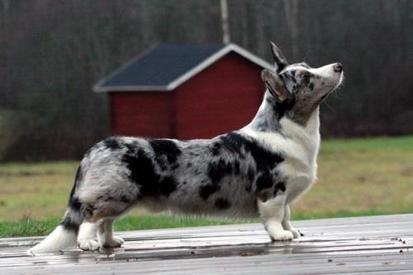
This article also relates to: Pembroke Welsh Corgi
Thought to have been introduced to Wales along with the migrating European Celts, little is known of the breed's early origin although evidence suggests that the Welsh Corgi dates back as far as 1200. Separated from the Pembroke Corgi by the Kennel Club in 1934 in order to preserve the existence of the Cardigan Corgi, these two varieties of breed were imported to the United States by Mrs. Robert Bole of Boston, Massachusetts in 1931. In the years since, the Corgi has become one of the most recognised breeds, progressively popular as a house pet although still utilised in cattle droving in some parts of the world, aligning it with its ancient heritage.
Within the 'pastoral' branch of canines, both varieties of Corgi are traditional working breeds, adept at herding and retrieving. They are easily identifiable for their low to the ground, disproportionate bodies, possessing short legs, a wide skull, high-set ears and a short coat, common in colour variations of sable, tan, black, red and fawn. The Cardigan Corgi allows for more variation than the Pembroke, and all colour deviations are permissible, providing white is not dominant. Perhaps the most obvious difference between the two Welsh breeds relates to its tail, or lack of tail, as is the case with the Pembroke. The Cardigan boasts a long tail, whereas the Pembroke's tail lacks length, being often described as a 'bobtail.'
Whilst the Pembroke variation is often thought to be more highly-strung than its the cousin, such is not a fair assessment across the entire breed. Both can be stubborn in their independence, whilst equally capable of demonstrating obedience and sensibility. Due to their inherent love of people, which is demonstrated through their affectionate manner, the Welsh Corgi is the ideal breed choice for families or the dedicated sole owner. Vigilant to change and threat, the breed also proves an efficient watch dog. On average, a healthy Welsh Corgi will weigh 10-12 kg, with a life expectancy of 12-15 years when shown appropriate care, although it is not uncommon for a Corgi to outlive this expectancy.
Due to its characteristically long spinal column and short ribcage, the Welsh Corgi is susceptible to back complaints. Additionally, glaucoma is often associated with the breed. Because of its reduced proportions, the Corgi gains weight easily so feeding human foods is not encouraged; not only can weight gain be detrimental to the general well-being and activity of the dog, but it adds pressure to the fragile spinal column.








From United Kingdom
The Corgis are very intelligent dogs, they do not bark all the time. They are loving and fun to play with. They are like having a large dog just with short legs. They can walk forever. They are very attractive dogs, both the boys and girls alike. They are very well behaved in the main, although, like all dogs could eat whatever food is available.